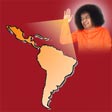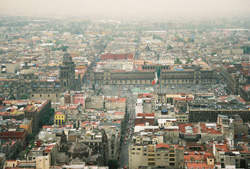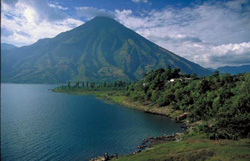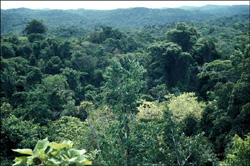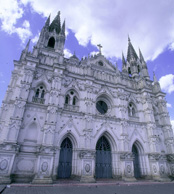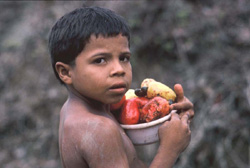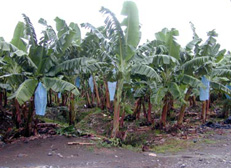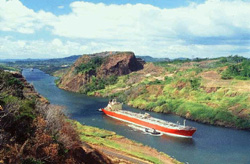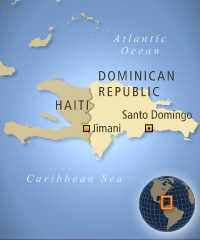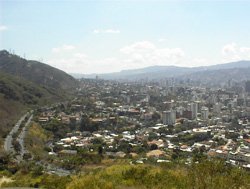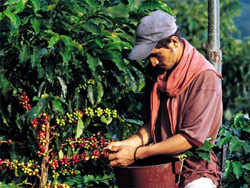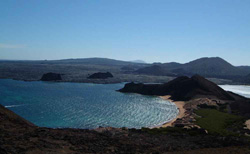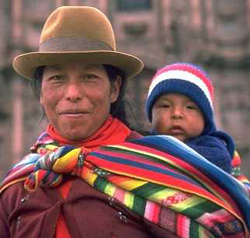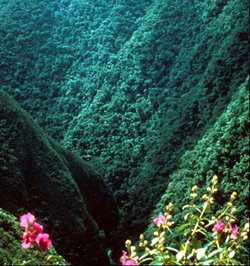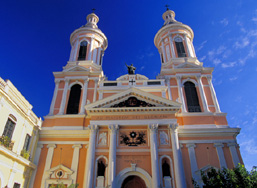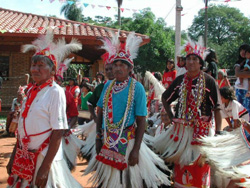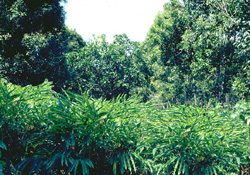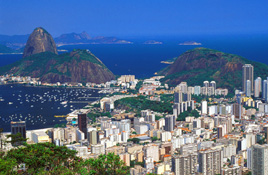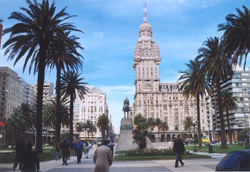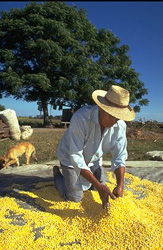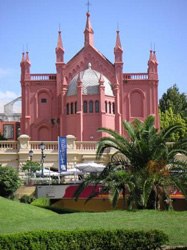AN
INTRODUCTION TO LATIN AMERICA
By Leonardo Gutter
This article first appeared in Heart2Heart,
April 2006.
In this introduction, we talk
mainly about the various countries in Latin America. Some information
about the Sai movement is given at
the end,
but most if it is in the articles for the countries.
Loosely
speaking, Latin
America is the part of the continent of America that lies
to the south of the United States. In a more strict sense,
the term Latin America stands for all the countries
that were once colonies of Spain, Portugal, and France. Since
Spanish, Portuguese, and French were all derived from Latin,
the term Latin America generally designates nations that were
once the colonies in the New World of these European powers.
In geographical terms, the American
continent may be considered to be made up of three parts: North
America, South America, and Central America. North and South
America are linked by Central America, which at one point becomes
very narrow.
Latin America as presently understood,
comprises 23 countries: Mexico, Guatemala, Belize,
El Salvador, Honduras, Nicaragua, Costa Rica, Panama, Cuba,
Jamaica, Haiti, Dominican Republic, Puerto Rico, Venezuela,
Colombia, Ecuador, Peru, Bolivia, Argentina, Uruguay, Paraguay,
Brazil, and the Guayanas. We begin with a description of the
region known as Central America .
CENTRAL AMERICA
GENERAL CHARACTERISTICS
|
This region comprises
Mexico, the countries that lie below Mexico right down
to Panama, and the Caribbean islands. Many volcanoes
crisscross the region from the West to the East. The
climate of Central America is generally warm, though
in the hilly regions it tends to be mild and pleasant.
Barring Cuba and Puerto
Rico where the population is predominantly white, in
all other countries the population is mixed, with some
whites, some blacks, some of Indian origin [not from
India!], and the rest racially mixed. The official language
in most countries is Spanish --Brazil of course being
a major exception, where the official language is Portuguese.
However, many other languages and dialects are also spoken,
especially where the indigenous population is predominant.
|
|
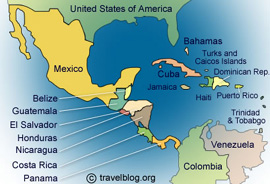
|
There is also considerable diversity
in the economic levels of the different segments of the population,
with many of them being quite poor.
Mexico:
|
|
|
Mexico, just south of the United
States, has the shape of a horn. It is washed by
the Pacific on the western side and the Atlantic on
the eastern side. The land slopes sharply on the Pacific
coast while the slope is gentler on the Atlantic side.
The capital city is Mexico City, which is at quite
a height above sea level. It is also densely populated.
The other big cities are: Guadalajara and Monterrey
.
The official language is Spanish. There
is no official religion; however, Catholics form the
majority. Thanks to the fertile soil, agriculture is
widespread, the crops raised ranging from corn, wheat,
and rice all the way to sugarcane, coffee, and cocoa.
There are also many industries. Mexico produces
oil, fifty percent of which is exported to the United
States.
|
|
Mexico
City - an aerial view
|
|
|
Guatemala:
Guatemala is a very mountainous country,
with land elevation varying quite substantially across
the country. As a result, there is a considerable variation
in the climate, the upper regions being cold and the
lower regions being warm.
The population is quite mixed racially,
with people of indigenous origin being in majority.
Most of the people are Catholics. The official language
is Spanish, and the Capital is Guatemala City. The
country is predominantly agricultural, and not very
rich. Sugar cane and bananas form the main export items.
|
|
|
| |
|
A Guatemala mountain
|
|
|
|
Belize:
This small country is located on the
south east of the Yucatan Peninsula, having Mexico
and Guatemala as neighbours. There are rich tropical
forests near the coast and pine forests in the interior.
Thanks to the moderating influence of
the sea, the climate is not as warm as it otherwise
might have been. The population is mostly indigenous
and of African origin. The country is poor and the
economy depends mainly on forest products. The capital
is Belmopan.
|
|
Rich forest in Belize
|
|
|
El Salvador:
El Salvador is flanked by the
Pacific, Guatemala, and Honduras. The country is mountainous
and there are many volcanoes. It is also prone to earthquakes.
The rivers are not very long and of torrential character, with
many cascades as they flow to the ocean.
|
|
|
|
|
A cathedral in Santa Ana
|
|
One of the many volcanoes in El Salvador
|
The Capital city is San Salvador
and the other big cities include San Vicente, Holy An,n and
Sansonate. Spanish is the official language, and the people
are predominantly Roman Catholics. The bulk of the population
is mostly racially mixed and also poor. Coffee, corn, cotton,
and sugar constitute some of the major agricultural products;
besides that, there is also some mining of gold, silver, copper,
and iron. Almost all the minerals are exported.
|
|
|
Honduras:
Honduras is a small country tucked between
the Caribbean Sea in the north and the Pacific in the
south, besides flanked by Guatemala, Nicaragua and
El Salvador.
The country is quite mountainous and
receives a lot of rain. The capital is Tegucigalpa,
and the population is mostly made up of people of mixed
racial origin.
A large part of the country is covered
by forests with cedar, mahogany, and oak. Agriculture
is the main occupation.
|
|
Friends in Honduras...
|
|
|
Nicaragua:
Nicaragua too is like most of
the central American republics: mountainous with many volcanoes,
sandwiched between the Pacific and the Atlantic, generally
poor, and ethnically diverse. There are some valuable mineral
deposits also. The capital is Managua, and the official language
is Spanish.
|
|
|
|
|
A child in Nicaragua
|
|
Banana - an important product in Costa
Rica
|
Costa Rica:
Another small country, very
similar to many others in the region but with a more humid
and tropical climate compared to the countries to the north
of it. As in most central American countries, banana is an
important agricultural product. The Capital is San Jose and
the official language is Spanish.
Panama:
|
|
|
Though a tiny country, Panama is probably
better known than most of its northern neighbours on
account of the famous Panama canal. Here, the huge
and expansive American continent shrinks to a mere
65 km or so. No wonder that the man-made canal linking
the Atlantic and the Pacific is located here.
On account of being an important maritime
highway, Panama naturally has a very cosmopolitan population.
Spanish naturally is the official language, but English
is quite well understood. There is of course agriculture,
mining etc., but the Panama Canal is unquestionably
the country’s greatest “industry”.
|
|
The Panama Canal
|
|
|
Haiti:
Haiti is truly an interesting country.
It forms the western part of a Caribbean island close
to Cuba. Historically, it used to be a French colony,
but the black slaves rose in rebellion and drove the
French out over two hundred years ago.
Thus Haiti not only became independent
a long time ago but also a French-speaking “black” republic!
As is to be expected, the official language is French,
another factor that makes Haiti unique. The capital
is Port au Prince, and the dominant religion is Catholicism.
Dominican
Republic:
This country occupies the eastern part
of the island of which Haiti forms the other part.
Historically, the Spanish ruled this part of the island,
hence Dominican Republic. Though similar to Haiti in
terms of topography, landscape, climate, etc., it has
a rather different cultural tradition and of course
language, which is Spanish. The population is made
up largely of people of mixed racial origin.
|
|
|
SOUTH AMERICA
GENERAL CHARACTERISTICS
|
The land mass normally
described as South America is not only huge but also
quite distinctive in many ways. First, there are the
tall mountains that run right through, almost close to
the Pacific coast.
To the east of the Andes
mountains, the land slopes toward the Atlantic, providing
a nice route for the many rivers rising in the Andes,
the famous Amazon being of course the biggest of them
all -– indeed, the Amazon can rightfully claim
to be the biggest river in the whole world.
The climate is predominantly
tropical, and the principal racial groups are the native
Indians, the blacks, the whites, and people of mixed
racial origin.
The countries that
make up South America include: Venezuela, Columbia,
Bolivia, Ecuador, Peru, Paraguay, Chile, Uruguay, and
of course the big ones, namely, Brazil and Argentina.
Spanish is the official language everywhere, except
in Brazil, where it is Portuguese, for well-known historical
reasons.
We now offer a thumb-nail
picture of the countries in the region.
|
|

|
|
|
|
Venezuela:
Venezuela is to the northeast of the
South American landmass and flanks the Atlantic Ocean.
It is partly mountainous and has many lakes.
The population is substantially of mixed
racial origin, with a small minority of whites and
blacks.
The capital is Caracas, the language
is Spanish, and most of the people are Roman Catholics.
Oil is the important produce, and there is some agriculture
as well.
|
|
Caracas - The capital of Venezuela
|
|
|
|
Colombia:
The Republic of Colombia
is between the Atlantic Ocean and the Pacific
Ocean, bordering Panama, Venezuela, Brazil, Peru, and
Ecuador. The soil of Colombia is characterized by its
immense variety.
The Andes dominate the
western region, and the Amazon has its origin there.
The capital is Bogota.
As elsewhere, Spanish is
the official language, and the population is mostly of
mixed racial origin. Coffee is the most important product.
The country is also rich in many minerals.
|
|
|
| |
|
Coffee picking in Colombia
|
Ecuador:
|
|
|
Ecuador is a small country
with the Pacific to the west, Columbia to the north,
and Peru to the south. The equator crosses through Ecuador.
There are many volcanoes. The capital city is Quito.
Guayaquil is another important city. The population is
quite mixed, being composed of native Indians, white,
black and people of mixed races. Spanish is the official
language. The country is, like many in the region, quite
poor.
Perhaps, Ecuador is most
famous for the Galapagos islands that belong to it. These
islands lie in the Pacific more than a 1000 km away from
the mainland, and this is where Charles Darwin made many
crucial observations that later led him to formulate
his famous Theory of Evolution. The country has some
oil and a lot of mineral resources. However, they are
yet to be exploited vigorously.
|
|
The Galapagos islands of Equador
|
|
|
Peru:
Peru is one of the important countries
in the southern hemisphere, with a substantial land
mass.
It shares with Bolivia, its neighbour
on the south east, the famous Titicaca lake. Its western
region is very mountainous with snow-capped peaks,
but to the east there are rich forests.
The capital is Lima, and the official
language is Spanish. Roughly 46% of the population
is made up of native Indians, besides which there are,
as elsewhere in the continent, the usual quota of whites,
blacks, and people of mixed racial origin. In addition,
there are many Chinese and Japanese immigrants.
|
|
|
| |
|
The Natives of Peru...
|
|
|
|
Bolivia:
This country, named after the famous
freedom fighter Simon Bolivar, is landlocked, being
surrounded by Peru, Chile, Brazil , Argentina, and
Paraguay.
There are some mountains. Part of the
country is a plateau, and part of it a plain.
More than half the population is made
up of native Indians, while the rest is made up of
the usual mix, including whites and blacks.
The constitutional capital is Sucre,
while the government works from the city of La Paz
.
The official language is Spanish, but
the use of native Indian languages is widespread. Mining
is the main industry.
|
|
Tropical forest in Bolivia
|
|
|
Chile:
Chile is a country with a unique
shape, a long narrow strip enveloping the Andes, bordering
the Pacific Ocean, and stretching right down to a point facing
the Antarctic continent. The capital is Santiago, and the population
is almost exclusively white. The official language is Spanish.
|
|
|
|
|
A church in Santiago, Chile's capital
|
|
Native Indians in Paraguay
|
Paraguay:
Paraguay is yet another landlocked
country, tucked between, Brazil, Bolivia, and Argentina. It
is relatively flat and semi-arid, with two big rivers running
across. The climate is warm and dry. The Tropic of Capricorn
runs through this country. Paraguayans are primarily native
Indians, especially of the Guarani tribe. The Capital is Asuncion.
The country has two languages, Spanish and Guarani. The economy
is essentially agricultural.
Brazil:
|
|
|
|
|
Spice garden in Brazil
|
|
Rio de Janeiro - a famous city of Brazil
|
Brazil is truly huge, with most
of the South American rivers that drain into the Atlantic,
passing through it, the Amazon being of course the biggest
of them all. There are numerous lakes in the country. The climate
is varied, being equatorial in some regions, tropical in some
places and subtropical in others. The population is predominantly
white, but there is a sizeable population of blacks and people
of mixed racial origin. In marked contrast to the other countries
in the region, Portuguese is the official language. Brasilia
is the capital, though Rio de Janeiro is probably better known.
Agriculture no doubt forms an important segment of the economy,
but Brazil is industrially quite advanced in many sectors.
In this respect, it stands out compared to many other Latin
American countries.
Uruguay:
Uruguay flanks the Atlantic coast, with
Brazil and Argentina as its neighbours. The river Uruguay
separates the country from Argentina.
The terrain is marked by gentle hills
making the landscape slightly wavy. The population
is made up mostly of immigrants from Spain and Italy.
The official language is Spanish, and
dominant religion is Catholicism.
|
|
|
| |
|
A park square in Uruguay
|
Argentina:
Argentina is a big country,
the western part being mountainous, the eastern part being
flat, and the region in between being a plateau. The population
is predominantly white. The official language is Spanish, although
in the interior where native Indians live, Indian dialects
are also spoken. The capital is Buenos Aires, and the people
are substantially Catholic. Agriculture is an important occupation.
The country also produces some oil. It has big reserves of
iron ore and natural gas.
|
|
|
|
|
An Argentinian farmer
|
|
A catholic church in Buenos Aires
|
The above is meant to be a general
introduction to Latin America. As can be seen, this part of
the world was opened up mainly by the Spanish, the Portuguese,
and to a smaller extent the French. Culturally, ethnicall,y
and economically and in many other ways, Latin America is very
different from USA and Canada.
The introductions to the various
countries in Latin America contain information on the Sai movement
in those countres.
But here, in terms of the Sai
movement, we note two important factors. First,
unlike Hislop, who played a key role in the Sai movement taking
roots in USA , one cannot identify one central figure associated
where Latin America is concerned. Second, unlike in USA and
Canada, there is hardly any Asian Indian population in Latin
America. Thus, the character and the growth of the Sai movement
in Latin America has a unique character of its own, and one
can clearly see Swami guiding the growth in His own special
way.
The Sai youth of Mexico are very
active in forming groups and looking for difficult service
activities. In Veracruz, a group of youth have been doing a
beach cleaning service, which no one wanted to do, not even
the authorities. Other youth have dedicated themselves to establish
electronic web information such as Sai Bhajans, discourses,
and a site for Sathya Sai EHV. Mexico will continue to lead
the way for many to find the Avatar in this historic moment
of time.

|
